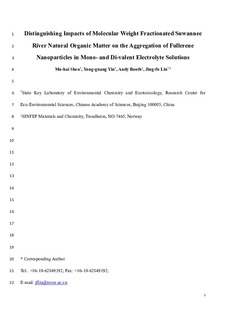| dc.contributor.author | Shen, Mohai | |
| dc.contributor.author | Yin, Yong-guang | |
| dc.contributor.author | Booth, Andy | |
| dc.contributor.author | Liu, Jingfu | |
| dc.date.accessioned | 2017-11-20T19:55:29Z | |
| dc.date.available | 2017-11-20T19:55:29Z | |
| dc.date.created | 2014-10-14T19:32:57Z | |
| dc.date.issued | 2015 | |
| dc.identifier.citation | Water Research. 2015, 71 11-20. | nb_NO |
| dc.identifier.issn | 0043-1354 | |
| dc.identifier.uri | http://hdl.handle.net/11250/2467228 | |
| dc.description.abstract | Given the wide presence of heterogeneous natural organic matter (NOM) and metal ions (Naþ/Ca2þ/Mg2þ), as well as their significant role in governing nanoparticle stability in aqueous environments, it is of great importance to understand how the molecular weight (MW)-dependent physicochemical properties of NOM impact fundamental transportation processes like the aggregation of engineered nanoparticles (ENPs) in the presence of Naþ/Ca2þ/Mg2þ. Here, we report on the aggregation behavior of a model ENP, fullerene nanoparticles (nC60) in the presence of five MW fractions of Suwannee River NOM (Mf-SRNOMs, separated by ultrafiltration techniques) and three electrolytes (NaCl, CaCl2 and MgCl2). We found that in all NaCl treatments and low concentration CaCl2/MgCl2 treatments, the enhancement of nC60 stability positively correlated with the MW of Mf-SRNOMs. Whereas, the stability efficiency of identical Mf-SRNOM in different electrolytes followed an order of NaCl > MgCl2 > CaCl2, and the enhanced attachment of nC60-SRNOM associations was observed in high MW Mf-SRNOM (SRNOM>100 kD and SRNOM 30e100 kD) at high concentration CaCl2/MgCl2. Our results indicate that although the high MW NOM with large humic-like material is the key component for stabilizing nC60 in monovalent electrolyte, it could play a reversed role in promoting the attachment of nC60, especially in long term aggregations and at high concentrations of divalent cations. Therefore, a detailed understanding of the effects of heterogeneous NOM on the aggregation of ENPs should be highly valued, and properly assessed against different cation species and concentrations. | nb_NO |
| dc.language.iso | eng | nb_NO |
| dc.rights | Navngivelse-Ikkekommersiell-DelPåSammeVilkår 4.0 Internasjonal | * |
| dc.rights.uri | http://creativecommons.org/licenses/by-nc-sa/4.0/deed.no | * |
| dc.subject | Natural organic matter (NOM) | nb_NO |
| dc.subject | Molecular weight (MW) | nb_NO |
| dc.subject | Fullerene nanoparticles (nC60) | nb_NO |
| dc.subject | Aggregation | nb_NO |
| dc.subject | Electrolytes | nb_NO |
| dc.title | Effects of molecular weight-dependent physicochemical heterogeneity of natural organic matter on the aggregation of fullerene nanoparticles in mono- and di-valent electrolyte solutions | nb_NO |
| dc.type | Journal article | nb_NO |
| dc.type | Peer reviewed | nb_NO |
| dc.description.version | acceptedVersion | nb_NO |
| dc.rights.holder | The authors | nb_NO |
| dc.source.pagenumber | 11-20 | nb_NO |
| dc.source.volume | 71 | nb_NO |
| dc.source.journal | Water Research | nb_NO |
| dc.identifier.doi | 10.1016/j.watres.2014.12.025 | |
| dc.identifier.cristin | 1164057 | |
| dc.relation.project | Norges forskningsråd: 209685 | nb_NO |
| cristin.unitcode | 7566,6,0,0 | |
| cristin.unitname | Miljøteknologi | |
| cristin.ispublished | true | |
| cristin.fulltext | postprint | |
| cristin.qualitycode | 2 | |

